Q1-2006, Parallel Filters
This stage is again about parallel filter design. The main difference this time is that these filters have been designed with the anechoic curves that we were able to measure at February 2006, providing better means for accurate filter design.Okke filter version 1
Based on the new curves, Okke Ouweltjes (quickly) designed a filter. This filter is not a fully polished filter, but is intended as a quick-and-dirty first step to check the validity of the anechoic curves. The schematics of Okke's filter are as follows: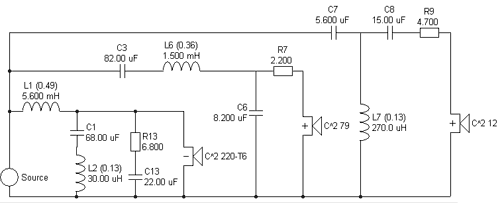
It results in 4th-order curves in the mid-treble crossover region, and 2nd-order curves in the bass-mid crossover region. L2 attenuates the 3.6kHz peak of the woofer. R13 and C13 are a Zobel to equalize the impedance of the woofer. The overall response looks quite equalized, with a small dip due to both the low-pass section of the midrange, and the dip the tweeter diffractions.

The in-house measured response is quite similar to the simulation (at 50cm distance, altitude between tweeter and midrange):
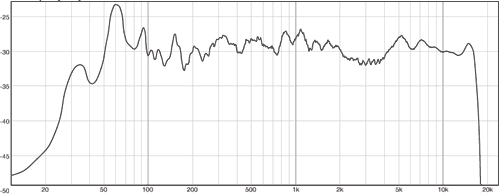
The phase response is pretty OK, as shown by the curve resulting from reversal of the midrange. There is some group delay between the tweeter and midrange (effectively putting the tweeter about 2 cm forward), but it remains rather constant

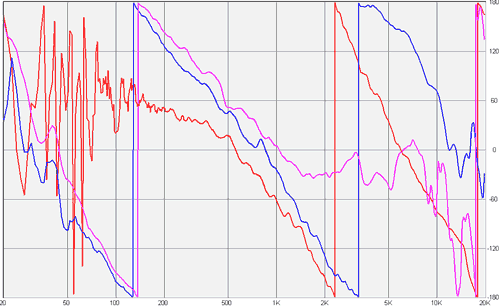
The impedance response looks quite OK as well, nowhere lower than 4 Ohms:
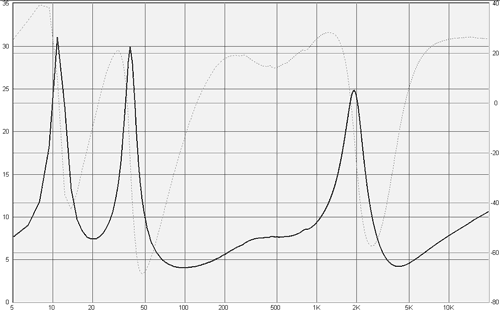
As the filter doesn't contain many components, it wasn't difficult to make a nice topology, with the 3 chokes oriented orthogonal in the 3 available dimensions. An impression of the filter, and speaker with felt is shown by the following two pictures.
The sound characteristics of the filter are good. It has a homogenous, integrated sound. It is the first filter that shows energy in the fundamental range (100-300Hz). There is plenty of bass and mid, giving a lot of energy to every note, but never becoming overly warm. Treble is smooth, and brilliant. The spatial image is impressively deep and wide.
The filter misses some texture, or what others would call an "airy sound". It could also be a bit more exciting, have more "micro dynamics", a bit more dramatic and/or romantic. The bass is also a bit "oinky", which can be explained by the Q of the filter. This also hints at fixes required for the tweeter circuit.

Nevertheless, this is the first filter design that sounds mature and complete. A big success, and finally a competitve high-end design!

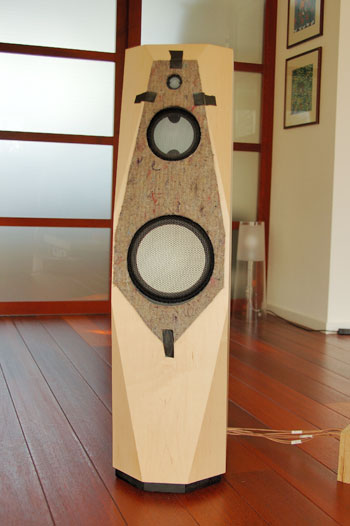
Okke filter version 2
Okke made an updated version of his first filter with less components, and a better phase response at the crossover point between midrange and tweeter. Furthermore, the filter shows a better response off-axis.This filter sounds very nice. It is one of the first filters that combines an impressive sound with a musical sound. This is the first filter that sounds "warm", where the fundamental area (chest of voices, cabinets of guitars, kettles of drums) integrates very well with the bass region. It never sounds over-romantic though as encountered with many speakers that try to increase the around 100Hz range to compensate for the lack of below-50Hz acoustic output. The filter has a "push", and adds a lot of musical energy to the music. Also the tweeter integrates very nicely with the midrange, and doesn't sound like a "separate sound source" anymore. Compared to the previous Okke filter, the voicing is almost completely gone. Overall, the timbre of the speaker has made significant progress.
Also spatially the speakers have a wider and deeper projection. I've experimented as well with the positioning of the speakers in the listening room, putting them in another positioning. The effect of that is incredibly large. Suddenly, there is air around the instruments, the spatial image becomes holographic, the timbre improves a bit more, and there is a lot of micro-dynamics added to the sound (i.e., overall energy and details integrate smoothly).
The effect of a warm sound with the "speed" of the ceramic units is truly amazing. Furthermore, the speaker seems to be an all-arounder. Whether you play classical music, jazz, pop, house, hard-rock, it doesn't matter. All goes very well. You can also see this from the fact that you tend to play very loud, at least 10dB louder than before.
Minor points are a bit of humming in the midrange (the peaks at 400Hz, or might as well be the room acoustics?), as well as the spatial imaging which could be more wide. The last is a trade-off. Putting the speakers wider apart gives you the impression being inside the musical performance at the expense of pin-pointing, putting the speakers closer together makes sound sources "touchable", but it is as if you're standing in front of the entry to a concert hall instead of inside the concert hall. For closely miked recordings there are no spatial objections.
This filter makes me very happy, and I wouldn't be surprised if we would end with this concept with some minor changes. The filter is currently playing with "cheap" components (e.g. C3 is a non-bypassed bipolair elco
Future plans are to first build the other proposals, and some derived ideas that are hidden in my laptop, select the best, and then finalize the topology. Then we'll search for a balanced set of components (it's too easy to apply "sky-is-the-limit" components everywhere). Which is another advantage of this filter, not too many components!
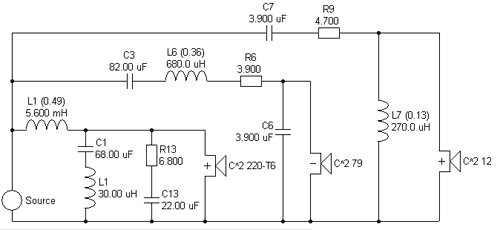
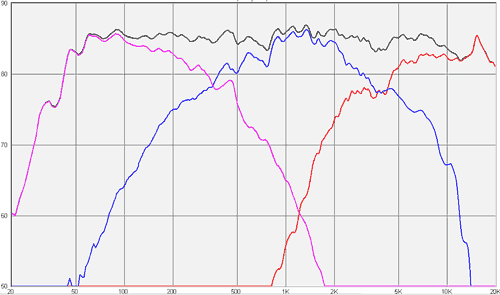
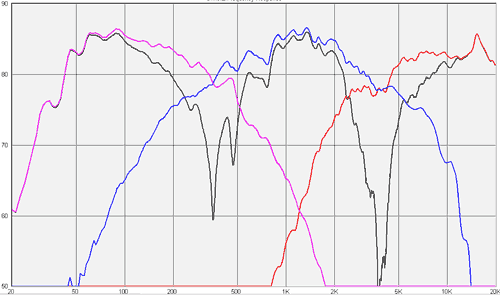
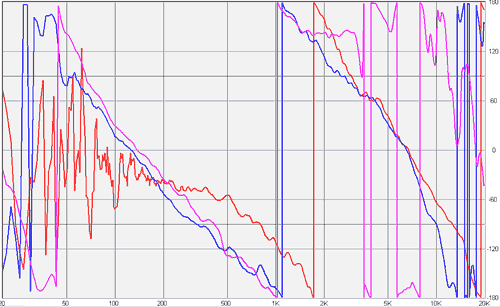
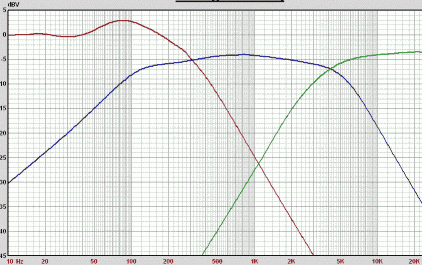
I've also added an experimental impedance compensation circuit (the exact values still to be determined), as the bass sometimes is a bit buzzy, depending on the placement of the speakers in the room. The compensation circuit makes the bass more punchy and direct, and also opens up the spatial image even more.
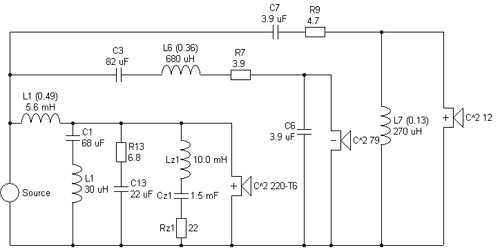
The solid line is the new impedance, the thin line the original, and the gray dashed line is the electrical phase.
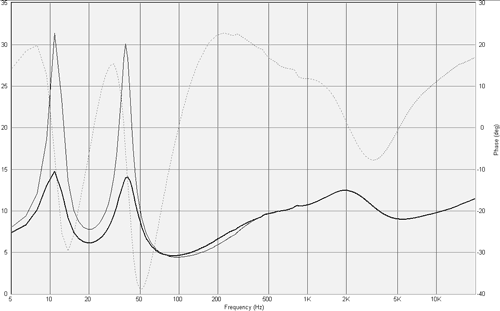
The following figure shows the effect of the compensation compared to the circuit without impedance compensation (dashed).
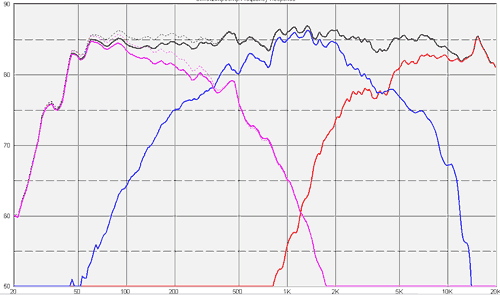
Avaclone filter
Starting with Okke's filter, modified by Paul Vancluysen, and subsequently optimized for phase alignment by me, the following filter resulted: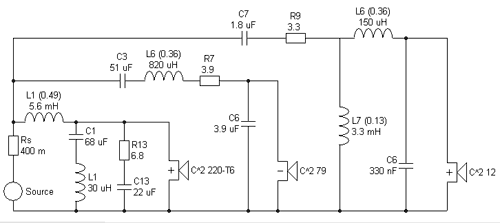
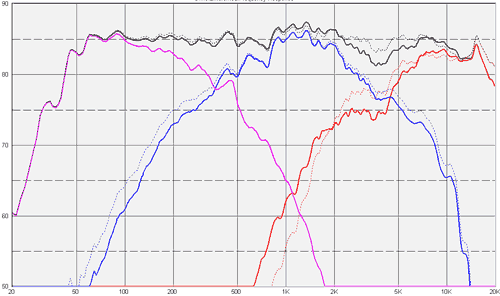

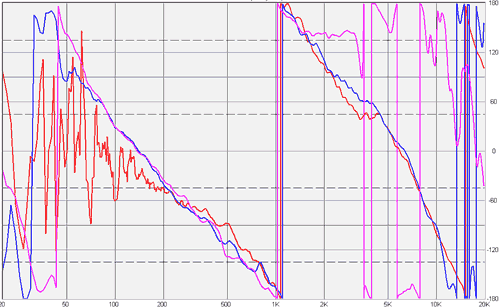
Quite nice aligned over a wide range! The amplitude response is less flat, and makes me think a bit of the Opus Ceramique response as published by Stereoplay. So I overlaid it with the Opus Ceramique response as published in Stereoplay (thin line). And guess what
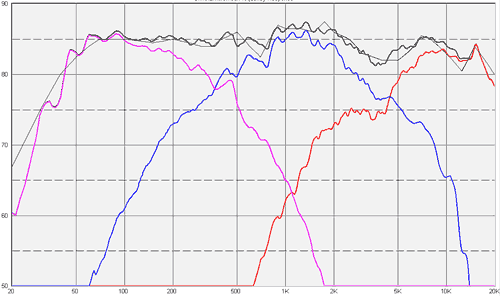
I'm not pretending that this equals the Opus Ceramique filter, and as I said before it is not my intention to replicate Avalons' design. But curiosity is there, so I've built and auditioned this filter.
The experiences are not so good. Although the filter has a warm sound, is misses live-like punch, and the treble doesn't integrate very well. It is either to much, with quite some sibilance on female voices, or it becomes dull.
Okke's filter revisited
It's not going to be more clear to the readers now by adding yet another filter, but his one is special for 2 reasons. First, it is a filter with a high fun factor, but the timbre is a bit nasal, and it is a bit on the analytical clean side. It serves as a reference filter for already quite some months, and it is a pleasure to listen to it, especially for popular and jazz music, despite its artifacts that become apparent with solo classical music (piano, violin, cello, etc.).The schematics of the filter, and some measurements can be found below (Okkev2MarcMod2 for internal reference).
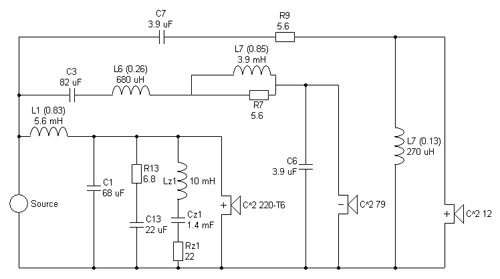

As we were quite satisfied with the filter, we've built one version with better components (MKP instead of bipolair elcos). The two filters are shown below.
Original:
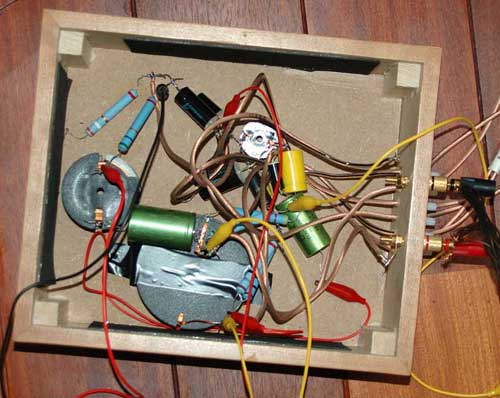
Upgraded:
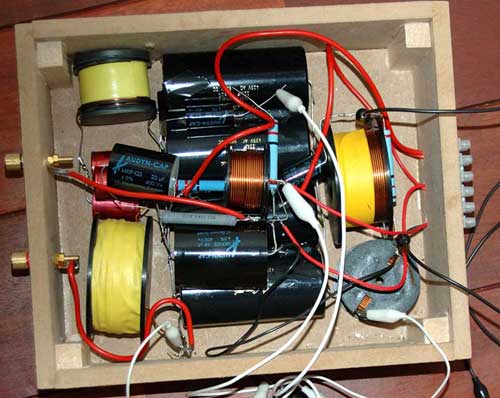
Exactly the same component values and topology. Despite all the upgrade effort, the original version sounded much better. The upgraded filter sounded "muffled" and "shut-in", and missed the fun and live-performance of the other filter. After stepwise select-replace, or changing component directions, two main victims were found:
- The wiring (now replaced by the same wiring as in the original filter), which affected the treble.
- The Mundorf 4x22uF. This is supported by other sources using Mundorf capacitors in electronics, encountering the same "blanket" and "haze" over the sound. Replacing them with an Audyn Cap or a bipolair elco improved the sound dramatically.
I'm don't want to over generalize by just a hand full of observations, but there is one important lessons to be learned from this. Just using expensive components does not mean better sound. We still use the original filter as our reference filter.
Updated filter
[10-6-2006] The filter published on 5-6-2006 contained a simulation error. The correct simulation showed a new potential, so I've constructed a slightly modified filter.This time, the filter originates from a very extensive and intensive interaction between listening, simulation, changing, checking the timbre with headphones and some other loudspeakers, connect a laptop and fiddle with an equalizer to get an impression of "I-want-more-I-want-less, listening to the units in isolation with different types of filtering applied etc. This takes a lot of time, but it is fun to do, and it is a good learning experience!
The starting point of this filter has been "Okke's revisited filter". The first obvious thing that needed attention was some humming in the fundamental region. Very apparent when for instance an E note of piano, guitar or voice was being played. Listening to the woofer in isolation showed that the problem was situated mainly there. The woofer also has a "metallic edge" to the sound. I've heard this effect in previous filters before as well, and my opinion is that the C^2 220 needs to be filtered with a low crossover point (preferably below 250Hz). This also means that the midrange needs a wider operating range, but more on that later.
Back to the woofer in isolation, I tried to increase the 5.6mH choke, add additional notches, add/remove impedance compensation, but finally ended up by adding a 100uF capacitor in parallel to the 68uF capacitor. This reduced the humming problem significantly, and resulted in a clean and dynamic sound, that even revealed some "openness" in the muddy sound timbre. The disadvantage is that such a large capacitor value leads to a 3 Ohm drop in the impedance curve at 100Hz (compared to 4.1 Ohm before). In the region from 40-100Hz the capacitive load seen by the amplifier is about 150uF! Hence, a "decent" amplifier is needed to cope with this design.
I've also measured the acoustic effect of the 30uH choke in series with the 68uF capacitor, which should suppress the 3.5kHz peak of the woofer. The effect is minimal, and experiments show that a 0.37uF capacitor in parallel with the 5.6mH choke works out better. I've added a 0.33uF tin-foil capacitor (because of its low inductive properties). When listening to the woofer in isolation, the effect of this capacitor is very obvious. With the midrange connected, the effect becomes less obvious, as the peak is 40dB below reference level. But having learned how it sounds in isolation, in cases like choir music the effect is still there, so the capacitor makes sense.
I didn't like the large values of the notch circuit (10mH and 3x 470uF). As the operating range of the woofer is smaller now, the same effect can be accomplished by a plain resistor of 33 to 47 Ohms parallel to the woofer. My impression is that such a resistor is not needed, it removes the fun and punch. In total, the woofer sounds completely clean, free from stress, and vivid!
Determining the exact level of the midrange units is not easy. Differences of 0.5dB are quite audible, and change the timbre of the speaker. This also greatly depends on the "context", i.e. the way the woofer and tweeter are tuned. Where first I had a slight preference for some voicing, in this case careful listening to equalizer settings, reference headphones and intermediate tweaking learns a "flat" response works out well, at the expense of not masking a tiny bit of sibilance anymore. As the response also needs more push in the low midrange area (because the woofer is steeper filtered), R7 is shortcut with a choke! I've also increased L6 and C6 to decrease the amplitude around the 2kHz area a bit. This region is the presence area, but an excess makes the overall sound image a bit harsh (an easy pitfall for the Thiel units). Last but not least, C3 has been increased to phase-align the midrange unit with the woofer. A bigger spatial image is apparent.
Regarding the tweeter, accidentally because of simulation errors before, I discovered the phase can be aligned and the amplitude can be flattened by adding a resistor in series with L8. R9 has been paralleled with two resistors of 10 Ohm, and C7 has been increased to 4.7uF. I tried some modest filtering of the peak at 12kHz, but it made the sound dull.
Component choices have been more carefull than before. C7 and C6 are AudynCap Plus, which was a clear improvement. Pinpointing of sound sources improved, as the treble didn't smear anymore. In the near future I'll pay more attention to obtain a balanced component selection.
The new filter circuit and measurements look as follows (called Okkev2MarcMod3 for internal reference):
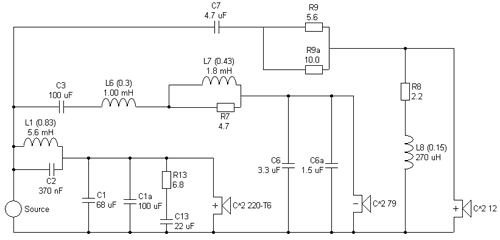
The current component list is as follows:
- L1, 5.6mH, 1.4mm air, Intertechnik
- L6, 1.0mH, 1.4mm air, Intertechnik
- L7, 1.8mH, 1.4mm air, Intertechnik
- L8, 0.27mH, 1.4mm air, Intertechnik
- C1, 68uF, MKP, Audyncap
- C1a, 100uF, bipolair, F&T
- C2, 0.33uF, KP-SN, Audyncap
- C6, 3.3uF, MKP, Audyncap Plus
- C6a, 1.5uF, MKP, Audyncap
- C7, 4.7uF, MKP, Audyncap Plus
- C13, 22uF, MKP, Audyncap
- Rx, all resistors are MOX-10.
The frequency response is rather flat. There is a dip at 800Hz and 4kHz because of the units, and the bass response is extended a bit.
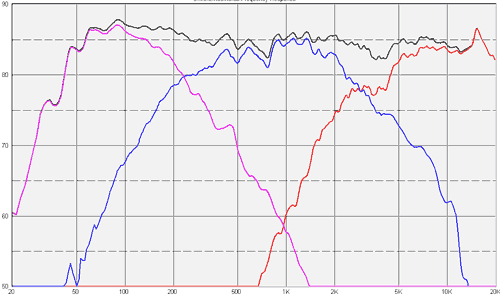
Comparison with the Okkev2MarcMod2 filter:
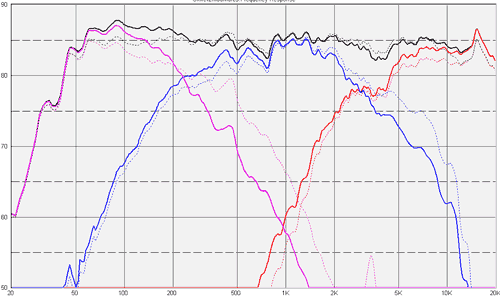
Comparison with the Okkev2 filter:
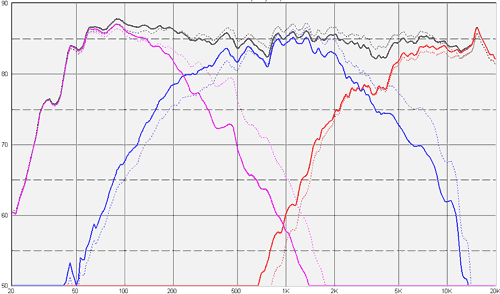
In both cases you can see that slopes and crossover frequencies are shifted, but the overall response is quite similar.
Antiphase is pretty OK.
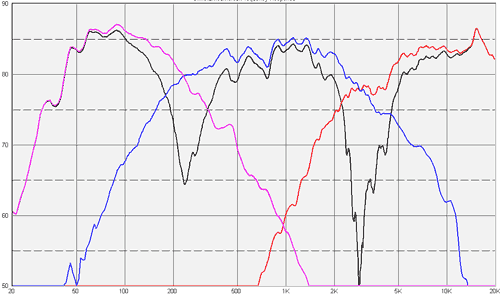
Woofer and mid align pretty well at the crossover point.

The impedance dips towards 3 Ohm, and relies to a certain extent on the series impedance of the 5.6mH choke!!

The voltage curves look nice, giving the 100Hz range a bump (which is needed for these "thin sounding" Thiel woofers), giving more push to the upper fundamental for the midrange, and creating some overlap between woofer and midrange, adding to the off-axis energy response as well.
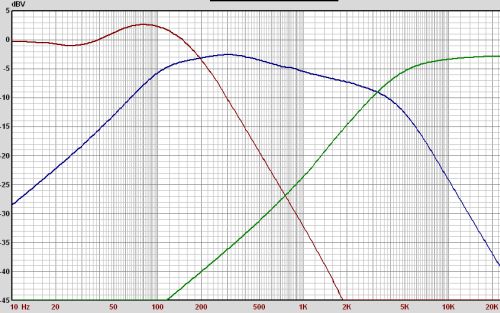
Although it looks like tweaking, this filter design is a big step forward again (supported by many friends who heard the result). The overall sound of the filter is very nice and appealing. This filter combines all the previous advantages (integrated sound) with a more intimate and exciting presentation combined with a bigger scale of authority. When chatting with friends, the music just captures your attention in a positive way, and you start listening to the music, even if it is played softly. Somehow it starts to get involving... Yes, I'm getting enthusiastic here!!!
What can be improved? The treble could be slightly more singing, but this is not just a matter of lowering the series resistance, as it introduces sibilance beyond this point. For tune amplifiers the impedance requires some attention as well. Maybe some more punch in the base drum range (feel it kick in your stomach).
Timbre Update [18-06-2006]
The weather turned bad, and I got an idea to align the phase, and to straighten the response within the limits of the units. The result is a more dynamic sound, a deeper and wider spatial image, and an extreme silence "between the notes". As far as timbre is concerned, I'm ready! A bit more spatial depth, and a bit more controlled bass, a little bit less harshness, and I'm completely ready. Without explanation, the schematics and curves (comparison is with Okkev2MarcMod2).
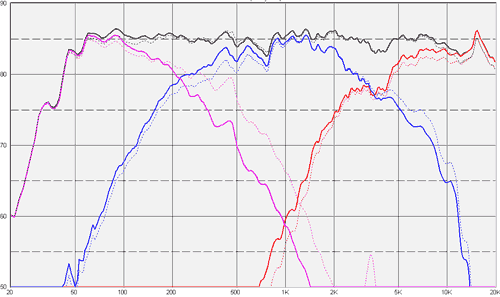
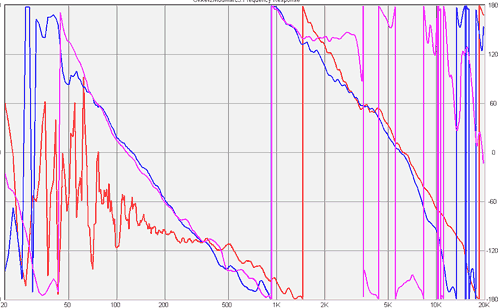


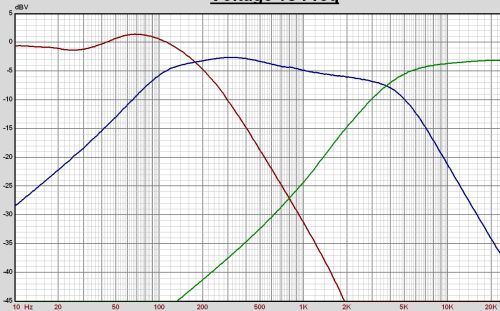
Further phase alignment [21-06-2006]
Together with Rob Dingen, I found out that the phase of the tweeter can be better aligned. This can be accomplished by increasing the value of the resistor in series with L7. This also allows to lower the value of R9, making the sound more fresh, but without adding sibilance. I've also applied some timbre updates.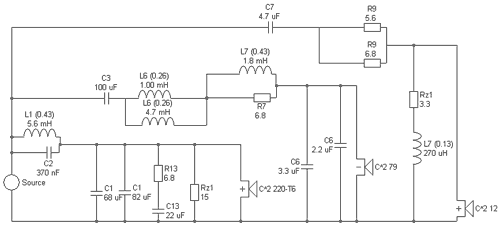
One significant update is the replacement of L1 from a 1.4mm air-choke to a 2mm air-choke. Though hard to believe in the first place, it has a significant and positive effect on the integration of the treble with the mid. I've "shown" the result to some friends, who support this observation. In real life a choke is not an ideal choke, and this effect can be explained from that perspective. Without comment, the response curves:

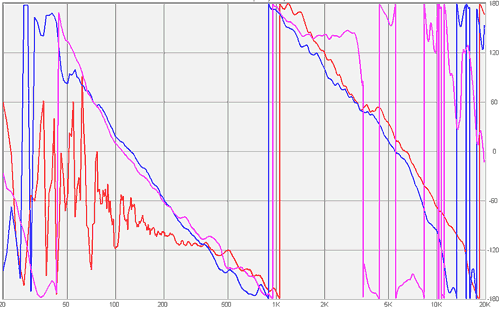
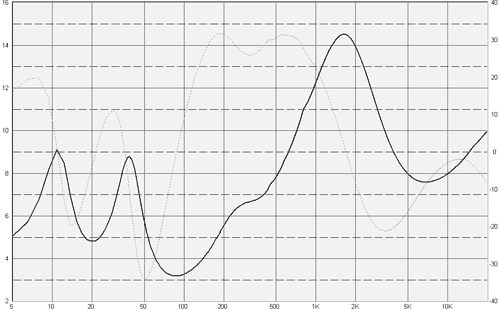

Back to fourth order [02-08-2006]
Inspired by some ad-hoc modifications, and experiences from the past I've developed a new filter. I've also evaluated the proposals and added comments.Wishes:
- More resolution in the mid-treble area. Treble may be a bit more fierce, but not at the expense of sibilance.
- More controlled bass. It is a bit uncontrolled with acoustic rolling jazz bass.
- Less muddy bass/mid, but keep the "warm sound". Maybe the baffle step on the mid is too enthusiastically?
- More texture or harmonic structure. My suspicion is that the room acoustics play a dominant role.
Some initial design constraints are:
- As a start, a flat frequency response. Exceptions are the tweeter above 10kHz, around 4kHz (diffraction), and the midrange from 500-900Hz (deviations in the response curve).
- Phases of the units aligned as much as possible. When aligning the phase of the midrange and tweeter for a 2nd order crossover, this always results in a dip in the frequency response around 4kHz, starting at 2kHz. This hints at a higher-order filters.
- The electrical transfer function should remain below 0dBV, so no electrical resonances
- This time, also take the off-axis response as a design parameter to be optimized. The off-axis response is difficult to optimize with a 2nd order filter between the midrange and the tweeter units. The midrange units has a prominent attenuation after 3kHz, and should already be attenuated at that point. Listening to the tweeter in isolation, Okke's first filter and Jon Marsh's filter hints at more resolution with steeper filters, so I choose for a 4th order Linkwitz-Riley filter.
- Try to keep the impedance above 4 Ohms.
With my laptop on my lap in the garden, and a glass of rose wine, I managed to create the following circuit (click on the circuit for a full resolution version).
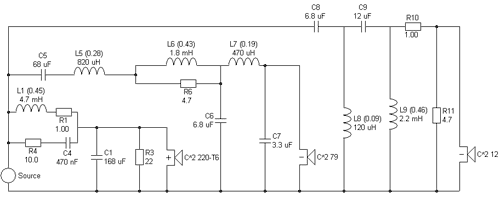
Frequency response is very flat, and phases are very nicely aligned (comparison curve is Okke2Marc4).
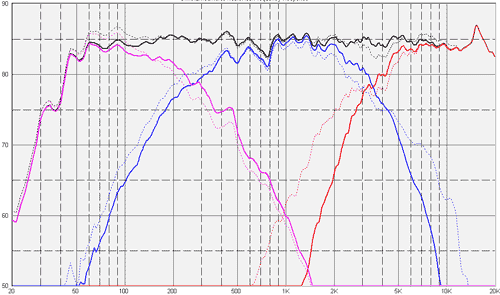
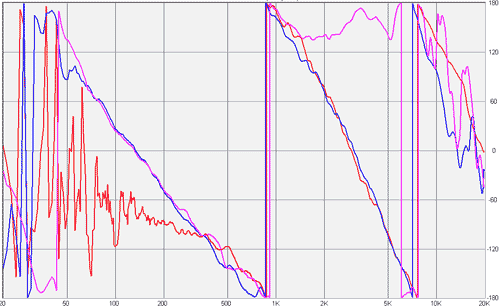
The response at 0/15/30 degrees has a gradual decrease in magnitude, so I expect a good power response (for an explanation of the difference between power response and on-axis response, see the following web-page).
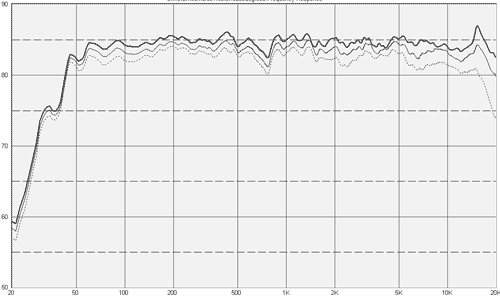
To be honest, I'm quite surprised I managed such a good combination of the magnitude/phase/off-axis response.
The electrical response shows no prominent resonances:
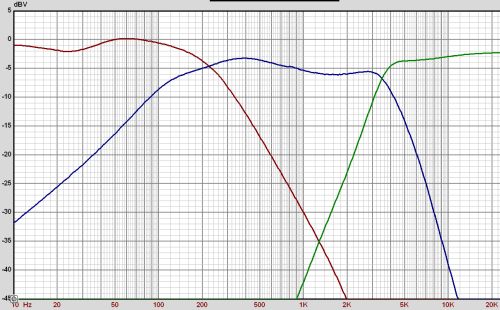
The impedance just drops below 4 Ohm, this time at the treble. This I cannot prevent, because otherwise the treble circuit gets some electrical resonances.
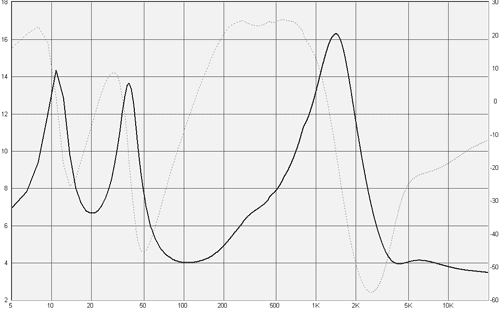
Tube amplifier users might consider some compensation circuitry for the impedance peak at 1.5kHz, as they might emphasize the presence area a bit. A simple compensation circuit parallel to the source, flattens the impedance without affecting the magnitude and phase of the filter.
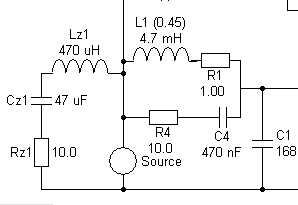
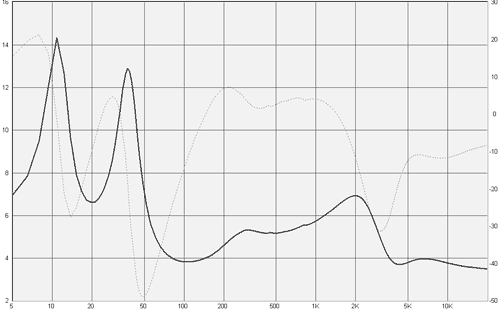
Compared to the previous filter, this filter sounds very clean, has an incredible resolution, treble is about perfect in my humble opinion, and bass is very well controlled giving a nice push to the sound. The overall timbre is a bit thin in the fundament area, but certainly not in the bass area. I present some tweaking for this later on.
The mid lacks an airy and harmonic structure, but this is caused by the acoustics (see the measurements later on). I think this is, again, quite a step forward. To be honest, I wouldn't be surprised that after applying decent components and some minor tweaking, the filter is finished.
Listening to the midrange and tweeter only is scary. Electrostatic resolution, but the dynamics are huge! Connecting the woofer afterwards reveals some slight cabinet resonances, but listening to the woofer and midrange only shows a good extended sound.
The spatial field is enormous. Very deep and wide. Change of timbre doesn't make sound sources change their position in the spatial field, as is often the case.
Measurements
I've also performed some measurements to see whether the filter works as expected. This gave me some interesting information. The mid-treble looks very nice: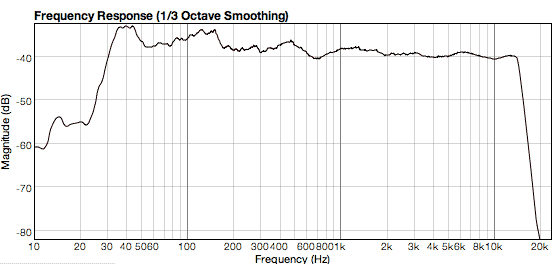
There is a small bump from 1-2kHz. This is caused by the reflections in my room. The impulse response of the measurement very clearly shows the reflections:
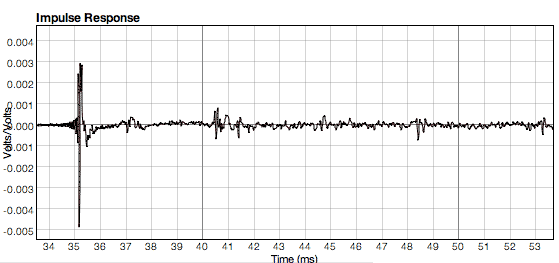
Setting the FFT-window such that the reflections are gated, results in the following response:
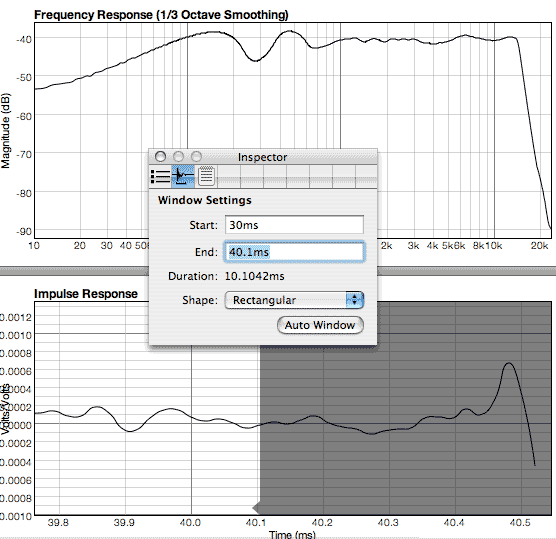
Or compared in one graph one can see my room adds 2dB of garbage...:
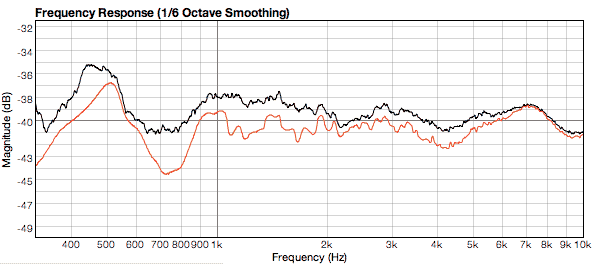
Understanding this "evil room", the units curves combined look as follows (measured closer to a wall, so even more echoes in the midrange area!!!):
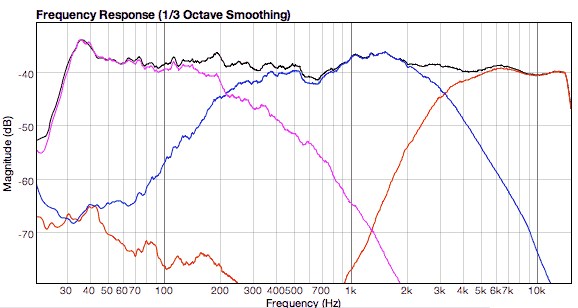
And the polarity of the midrange reversed to check the phase behavior:

Which windowed also looks better for the crossover at 3.5kHz:

Concluding one can say the measurements look fine, and show the filter works as expected.
Timbre update [09-08-2006]
Last but not least, I carefully added a bit more body to the sound, without sacrificing the resolution. This results in R1 being lowered to 0.5Ohm, and R3 to 15 Ohm. Though sounding warmer, lowering R1 more, or increasing R3 affects the resolution too much.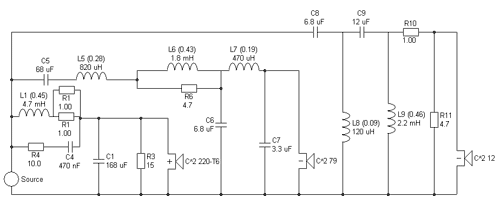

It even fully flattens the curves until 60Hz (including the baffle step)!
Exploring alternatives yourself
One nice property of this filter is that it can be easily changed to create different timbres, without affecting the phase alignment and off-axis response too much. The following figures give an impression:Bass Region Can be controlled with R1. Lowering R1 too much, will affect the impedance directly. So lowering R1 to 0 Ohm would drop the impedance at 100 Ohm to 3 Ohm. R1 slightly influences the fundament region as well, but that can be compensated with R3.
For more bass, decrease R1:

For less bass, increase R1:
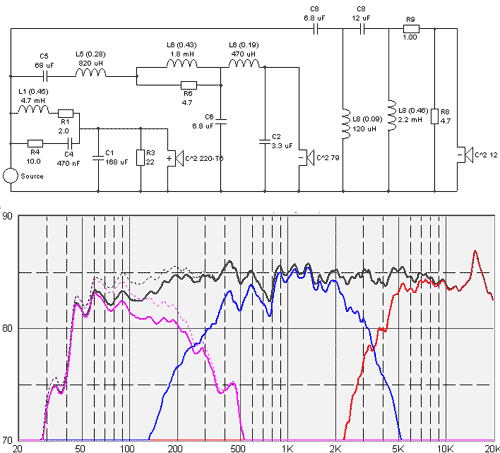
Fundamental Region Can be controlled with R3. Lowering R3, also lowers the impedance peaks in the bass region, making the filter less capacitive.
For more fundament, increase R3:

For less fundament, decrease R3:

My opinion is that increasing the fundament too much, affects the resolution and transparency in a bad manner. In practice, R1 and R3 need to be tweaked together.
Midrange Region The midrange region can be controlled with L6, affecting the phase response a little bit. Together with R1 and R3, it can be used to determine the exact amount of baffle step applied, or control the bass-fundament-mid level when the speaker will be positioned closer to the wall.
To obtain more midrange, lower L6:
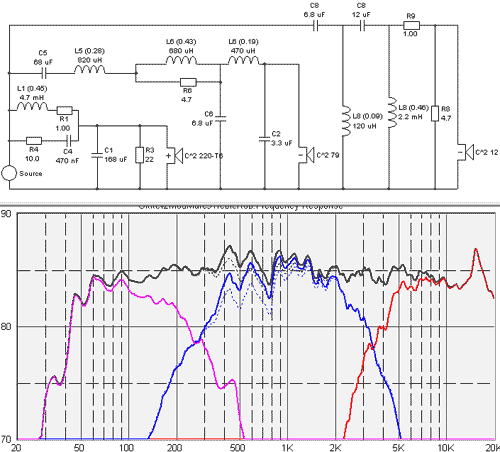
To obtain less midrange, increase L6:
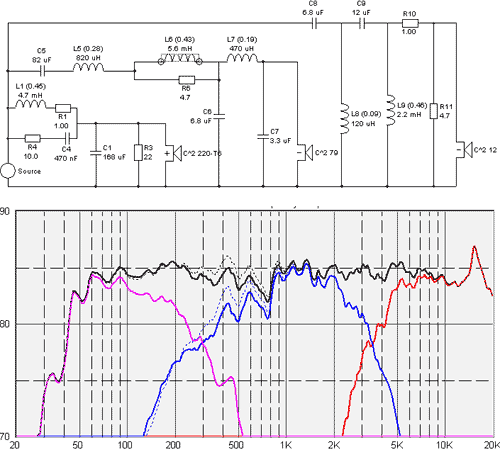
Phases are affected slightly:
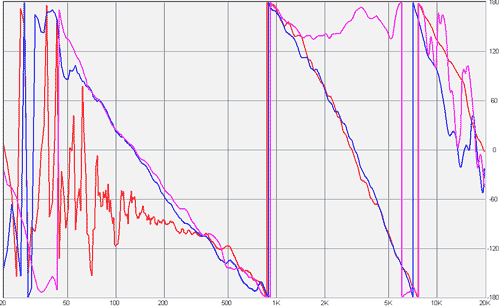
Upper Midrange-Presence Region Can be controlled with R6. This is a highly sensitive point in the circuit. Too much midrange makes voices sound very forward, but it also affects the stereo image drastically. In my case, it heavily interacts with my acoustic environment, so in my case a slight increase of R6 to 5.6 Ohm works out very well!
To obtain more upper midrange and presence, decrease R6:

To obtain less upper-midrange and presence, increase R6:
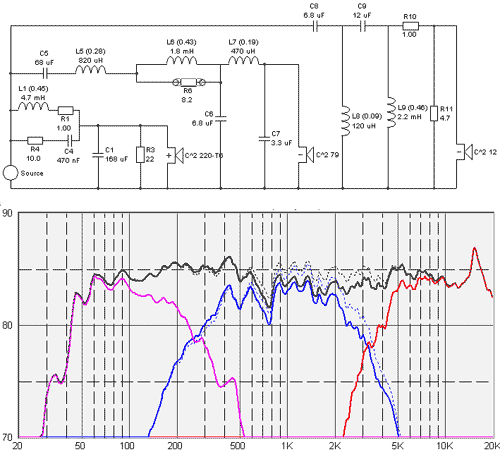
Treble Region As R10 and R11 are required for dampening the electrical resonance, R10 can hardly be changed on itself, and R11 can only be lowered. As R11 also determines the impedance in the treble region, lowering it too much is not a good idea. It is probably wiser to add an L-pad instead. Anyway, lowering R11 a bit is still permitted, and has a huge effect on the treble:
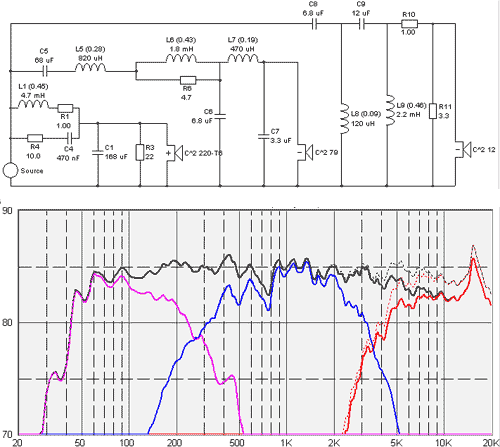
Increasing R10, and decreasing R11 leads to a nice "English" curve (gradual decay of the treble):
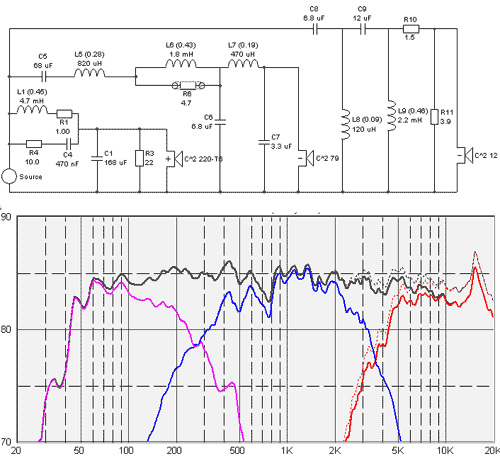
So, for instance one could create a gradual decaying response by combining the described tweaks as follows:

next->